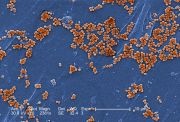New strategies against MRSA
A new paper by Shahriar Mobashery, Navari Family Professor in Life Sciences at the University of Notre Dame, and researchers in his lab provides important insights into promising new antibiotics aimed at combating MRSA.

Methicillin-resistant Staphylococcus aureus (MRSA) is a major global health threat that kills approximately 20,000 people in the U.S. alone each year. Shahriar Mobashery is a world-renowned expert in antibiotic resistance and enzyme inhibitors and he and his research team have long probed the nuances of MRSA as a superbacterium.
The Notre Dame team investigated two new anti-MRSA β-Lactam antibiotics from the pharmaceutical company Cerexa Inc., which are currently undergoing clinical trails. Both are broad-spectrum antibiotics, but their activities against MRSA and multi-drug-resistant MRSA have been especially noteworthy.
Although current media attention to MRSA may make it seem to be a recent development, the first strain that came to be known as MRSA actually emerged in 1961 in the United Kingdom. This difficult strain of Staphylococcus aureus became a global scourge within a span of a mere few years. Whereas previously Staphylococcus aureus was exquisitely sensitive to β-Lactam antibiotics, a class that includes penicillins (such as methicillin), this variant became resistant to all of the commercially available members of this class of antibiotics. Clinicians had to turn to second lines of antibiotics, which were substantially less effective and often were toxic to the human host.
By the 1980s and 1990s, MRSA had become a serious clinical problem, dreaded by clinicians in health care facilities, prisons and nursing homes. Of late, a new variant of community onset of antibiotic-resistant staph infections emerged outside of institutions.
"For the past 50 or 60 years, we've been able to stay one step ahead of traditional infections," Mobashery said. "However, there are cases of resistance to all eight major existing classes of antibiotics. Actually resistant bacteria are often resistant to multiple classes of antibiotics, not just one or two."
For just over 40 years, scientists have known that bacteria possess a cell wall. Since the health and integrity of the cell wall are critical to the survival of these organisms, it is not surprising that many antibiotics work by either impairing biosynthesis of the cell wall, or simply bind to it to inhibit full structural maturation. In 2006, Mobashery and his team of researchers provided the first clear understanding of the structure of peptidoglycan, the building unit of the bacterial cell wall.
Peptidoglycan, a mesh-like network, is the building block of the bacterial cell wall and neighboring peptidoglycans undergo a so-called "cross-linking" reaction to generate the rigid entity known as the cell wall. Since bacteria cannot regulate their internal pressure, bacterial cells would burst apart and die if cross-linking did not occur.
β-Lactam (e.g., penicillin) and glycopeptide (e.g., vancomycin) antibiotics are designed to impair the bacterial cell wall and inhibit the process of cross-linking, causing bacterial cells to burst and die.
Mobashery and his team have been focusing on a unique protein called penicillin-binding protein 2a (PBP 2a) that MRSA carries on its cell membrane. Previous research has shown that PBP 2a performs the critical cell wall cross-linking reaction.
Mobashery has previously reported that PBP 2a exists in "closed and open" forms. The open form is needed for the physiological functioning of PBP 2a, but the closed form is responsible for the antibiotic resistance manifestations. When the protein interacts with the cell wall at a specific location on its surface, it opens up to carry out the physiological function.
12.08.2008






